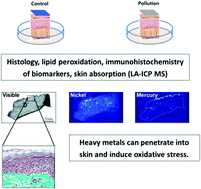Elemental and molecular imaging of human full thickness skin after exposure to heavy metals
Abstract
Compelling evidence suggests that heavy metals have potentially harmful effects on the skin. However, knowledge about cellular signaling events and toxicity subsequent to human skin cell exposure to metals is still poorly documented. The aim of this study was to focus on the interaction between four different heavy metals (lead, nickel, cadmium, and mercury) at doses mimicking chronic low-levels of environmental exposure and the effect on skin to get better insight into metal–cell interactions. We provide evidence that the two metals (lead and nickel) can permeate the skin and accumulate at high concentrations in the dermis. The skin barrier was disrupted after metal exposure and this was accompanied by apoptosis, DNA damage and lipid oxidation. Skin antioxidant enzymes such as glutathione peroxidase and methionine sulfoxide reductase are also heavy metal targets. Taken together, our findings provide insight into potential mechanisms of metal-induced oxidative stress production and the cellular consequences of these events.



 Please wait while we load your content...
Please wait while we load your content...